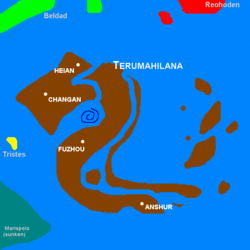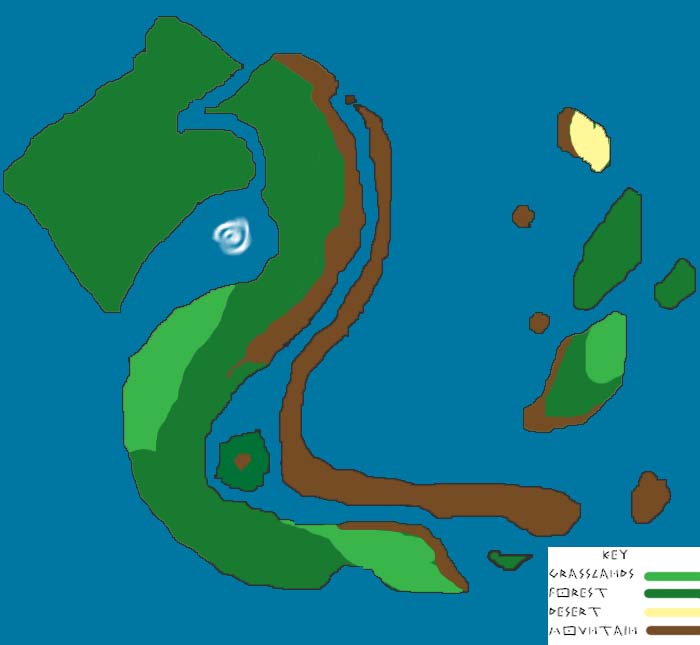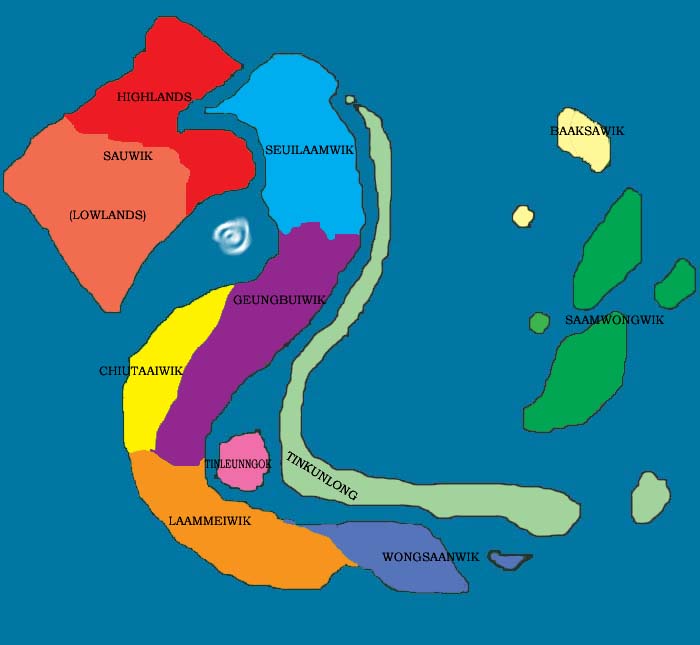Difference between revisions of "Terumahilana"
(→Today) |
|||
| Line 8: | Line 8: | ||
image_map = Map_terumahilana.gif| | image_map = Map_terumahilana.gif| | ||
official_languages = Lanese| | official_languages = Lanese| | ||
| − | capital = | | + | capital = Heian, Fuzhou, and Peining | |
| − | largest_city = | | + | largest_city = Heian| |
government_type = Feudal| | government_type = Feudal| | ||
leader_titles = Title| | leader_titles = Title| | ||
| − | leader_names = | | + | leader_names = Northern Kingdom Emperor: Mingkwok, Middle Kingdom Emperor: Ningho, Easter Kingdom Emperor: Junli | |
| − | population = | | + | population = 25 million | |
sovereignty_type = Settlement| | sovereignty_type = Settlement| | ||
established_events = | | established_events = | | ||
Revision as of 15:00, 7 April 2007
| Expert | Nekogami and Taiar | ||
| |||

| |||
| Capital | Heian, Fuzhou, and Peining | ||
| Largest city | Heian | ||
| Government Title
|
Feudal Northern Kingdom Emperor: Mingkwok, Middle Kingdom Emperor: Ningho, Easter Kingdom Emperor: Junli | ||
| Settlement |
|||
| Official Language(s) | Lanese | ||
| Official Religion | ancestral worship | ||
| Currency | gum | ||
| Predominant resident races are humans and Long. | |||
Contents
Briefly
"Terumahilana is home to two distinct groups: humans and the Argovian dragons called "Long". Long are very unlike Aldrosian dragons as they have a complex society of clans and are quite physically different. What ties them most to draconity are there elemental affinities and abilities, though they are wingless. The humans have close ties with the Long but interbreeding is rare despite this closeness. It is comparable mostly to Ancient China.
"Cities:
"In the North: There is Heian and Changan. In the middle there is Fuzhou and to the south Anshur. Heian and Changan are closests to Beau and the hub of trade for Terumahilana." The noted cites are the biggest in Terumahilana.
-- Nekogami
Topography
Tou Dei Gung is predominantly covered by lush tropical forest and some decidious forest in the mountainouns regions. Grasslands are in the west, south and on Hainan Island.
The shape of Tou Dei Gung resembles a Long, with the head being the Kaohshiung Island. The body being Canton Island, the spine being the Tinkunlong Mountain range and the tail being the mountainous islands to the east. This shape seems to verify the tails in the ancient writing "Gulao Rizhi" written some several thousand years ago by an unnamed author or series of authors. In the tale it states that the goddess Tinkunlong sacrificed her body to build the islands. This goddess is sometimes shown as a silver or pearlescent long or a human woman. There is some thought by scholars that Tinkunlong is similar or the same as Igala's Ryuugami or Alexandria.
Regions
History
"Excerpts from the Gulao Rizhi (Ancient Diary)"
Creation of Tou Dei Gung:
At one point the universe was nothing and from his nothingness came the possibility of existence and the gods. Because they were possible they existed. And from the numerous gods were two gods: Tinminglong and Tinkunlong, brother and sister.
Seeing that beneath their bit of heaven there was but endless sea they pondered creation.
"With my sword I shall cut the sea into pieces; from them we will make land beneath heaven," said His Most Shining Tinminglong.
"The sea will not cut," answered Her Most August Tinkunlong.
"Then I will command the sea to part and underneath will be the land."
"The sea will not heed."
"At last, I will thrust my body into the sea and become the land beneath the heavens."
"The land will lie fallow." The sighs of Tinkunlong became the clouds. "I will be the land for my body is fertile with life because I am a woman." And without hesitation she flung herself into he sea and churned the waters. The spray and froth became the mist of the land. Her spine became the mountains and her fur and scale the grass and trees. The vermin on her body became the common beasts and the birds.
Seeing this, Tinminglong nodded is head with pleasure and shook the ornaments from his hair. They fell as rain upon the land and bloomed into the flowers.
"The land is beneath heaven," he said satisified. "It is good."
Creation of the Long:
There was heaven and there was earth beneath it. The common beasts ruled over the land and Tenminglong felt fulfilled. It was not long before her brother filled with jealousy. His body had not the ability to create life from within it.
In his jealous fury, he split the heavens with his spear and it struck where the heavens met the earth. Springing from the tip of the spear was Tinlong and from his shadow Yinlong. Next he pierced the land of Tinkunlong with his spear. Spring from the wound in the earth was a long tendril of blood which became Dilong. He thrust his spear into the heart of a volcano and thus sprang forth Xilong. He struck his spear against a raincloud and out fell Shenlong.
His furious creation left him so hungry that he swallowed several whole deer. Until this time Tinkunlong was pleased to let her brother ride out his tantrum until she saw that he ate her favorite animal. She struck him on his back and he coughed the deer back up but they were changed into a Kirin.
Creation of Man from Dragons:
And the land was beneath heaven ruled by dragons. Tinkunlong was pleased. She loved he dragons for they were like her and they had sprang from her body from her brother's ferocity. Like them the dragons were wise but fierce. Quickly, the dragons worshipped Tinkunlong and not Tinminglong who had created them.
This angered Tinminglong, who dearly wanted children of his own. He lamented that from his body he could not birth as his sister did so freely. By this time, Dilong had many children, the most children of any of the dragons for having sprung up from Tinkunlong's body, he was the most fertile. The jealous Tinminglong gathered up as many eggs as he could and began to squash them into clay.
He squashed and squashed until the clay began to crumble and from the pieces sprang brown skinned creatures with two legs and no wings. They were fierce like dragons but small and without powers. So Tinminglong breathed into them his chi and they grew wisdom. His spilt his blood into them and they grew strong. He cried his tears upon them and they grew emotion. They were more plentiful than his sister's dragons and would reproduce much more efficiently. Though they were made from the bits of Dilong's eggs, they were short lived and it seemed that in the blink of his eye while there were less, there was still yet more. Pleased, he bid them worship his name and he would bestow his gifts upon them.
From the Anthropologist Briam Hedgewood
Lanese history can be separated into five periods.
| Date | Ruling entity | Emperor | Period/Culture | Other people/events |
| Before 200 BT | Hoiyan culture | Hunter-gatherers. Nomadic human society. Long unorganised. | ||
| 200 BT | The Five Emperors | Kwongning, Mougin, Sektin, Lihou, Tindi | Nghok Culture | Long unify under Kwongning and Long, Tinmouming. Wet rice agriculture. Settlements made. |
| 483 EP | The Golden Sovereign(s) | Chikent, Chihou, Chining | Nghok Culture continues | Tou Dei Gung unifies under Chikent. Long separate into two clans; Light and Dark. Arts flourish. Written language is made. |
| 665 EP | Dyunji culture | Political unrest. Long separate into 12 clans. | ||
| 817 EP | The Three Kings | Kwokning, Chingfungsin, Taailong | Ganga Culture | Country settles into three kingdoms encompassing the head island, the large two body islands and the tail islands. Taailong is first dragon emperor. War between Long Clans last for 50 years. |
Today
Termahilana has no enemies in the islands, maintaining good relations with all of the other nations in Argovia. Internally, however, skirmishes often break out between warlords and territories, but the overall climate is one of peace.
Miscellany
Flag
Specifications: The flag of Terumahilana is to be in the shape of a regular square. A circle should be placed in the center with a diameter of 13 units in ratio to 18 units of each flag side. The flag is divided symmetrically along the vertical axis in such a manner as to create four shapes, two of which are hemispheres of the central circle. These four shapes are colored with the flag's two colors in such a manner that a shape of one color touches only shapes of the other color.
The two colors of the flag are the aqua of the sea and earthen brown. The aqua is to be made of red, green, and blue in parts of 4, 11, and 10; the brown in parts of 7, 7, and 4.
While the flag should be vertically oriented, otherwise it is proper to fly the flag from either of the other two sides.
Symbolism: The geometry of the flag, with the perfect square and circle shapes and overall symmetry, represents balance--balance between the earth and the sea, light and dark, work and play, human and Long. At the flag's conception, the idea was to visually depict two very separate factors--such as the human and dragon cultures which comprise Terumahilana--forming a coherent whole.
To display the flag with a horizontal alignment is to be avoided as it places one of the "factors" distinctly above another. To do this as a foreigner is, at best, to show one's ignorance; at worst, it's a sign of contempt of local culture. As a native, to knowingly fly the flag the wrong way is a deliberate insult to both individual communities as well as the national community, which operates on the aforementioned principle of its different people working together. It may well be viewed as an attempt to cause harm to the community.
The colors are derived from the color of sea water and from the soil of Terumahilana, which provide the nation its primary sources of self-sustenance in the means of fishing and farming.
Money Matters
| Denomination | Shape | Material | Image |
|---|---|---|---|
| 1 | Small Circular | Nickle | Rabbit |
| 5 | Pentagon | Copper | Tenminglong Mountains |
| 10 | Oval with Grooved Edges | Steel | Panda |
| 50 | Diamond | Silver Alloy | Phoenix |
| 100 | Large Circular | Gold | Twin Dragons |
| 1000 | Bills | Paper | Seven Sages and the Boar |
| 5000 | Bills | Paper | Creation of Man from Dragons |
Terumahilana has the gum, which comes in denominations of 1,5,10,50, 100, 1000, and 5000. 1 gum is a small circular nickel coin with a rabbit on the front. 5 is pentagon made of copper with the Tenminglong Mountain chain on it. 10 is a steel oval with a grooved edge with panda eating bamboo on it. 50 is a silver alloy diamond shaped coin with a flying phoenix. The denominations have holes in their centers so that a string or rod may be put through them for easy arrangement or storing. The 100 gum is a large gold coin with twin dragons locking claws and has a grooved edge. The back of metal coins simply state the year of minting, the lord of the minting region, and the denomination amount in Lanese charaters. 1000 and 5000 gum are both paper denominations. 1000 gum depicts the story of the seven sages and the boar. 5000 gum has the creation of man from dragons depicted on it. There are Min Long Sutras on the back of these denominations for good luck and promotion of wealth.


